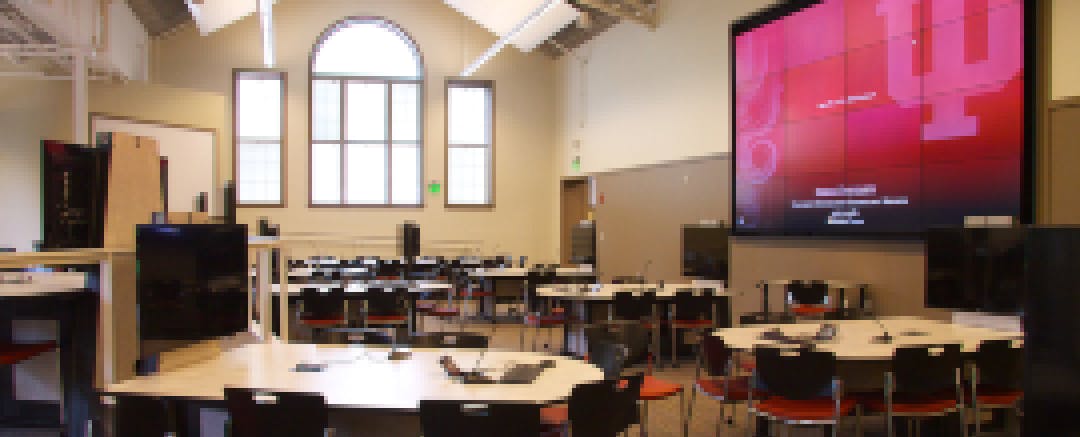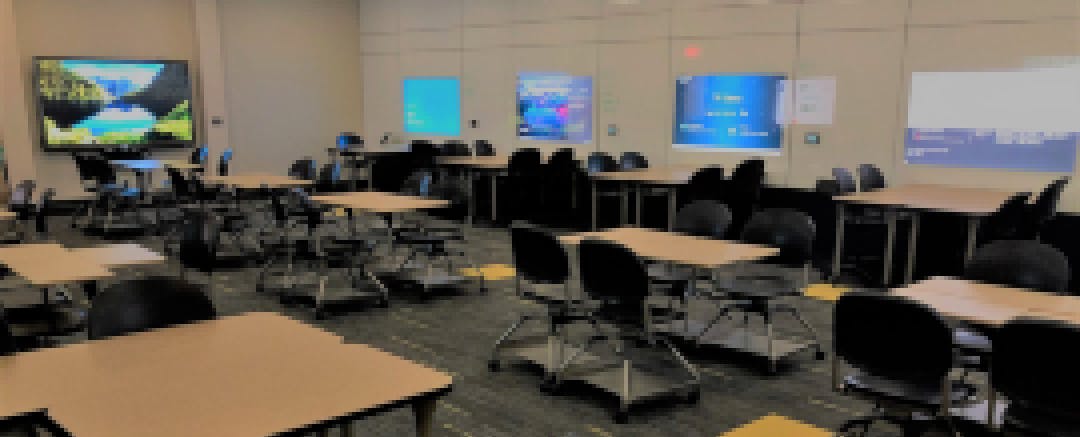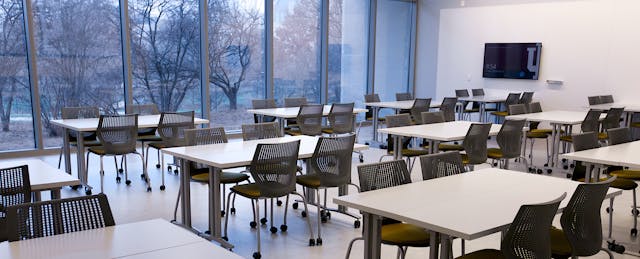Although a wealth of research suggests that active learning increases student engagement and improves academic outcomes, many college campuses struggle to get faculty to shift away from traditional, sage-on-a-stage style teaching practices. But some institutions are gaining traction using a novel approach: leveraging the expertise of facilities and information technology staff to support the redesign of classroom learning experiences.
The last wave of instructional initiatives in higher education saw colleges build centers of teaching and learning, sites where faculty could grow their skills and try out new teaching approaches. These centers offered access to tools and training on proven pedagogies and new technologies, but faculty often viewed using them as optional or an addition to their already busy schedules.
In contrast, Indiana University (IU) and the University of Central Florida (UCF) are exploring how pedagogy evolves when the actual environments in which students learn are transformed. Form follows function, as the adage says, but these universities are flipping that script and betting that a more flexible and adaptive form will unlock needed changes in the teaching and learning function.
Better Than the Sum of Their Parts: Coupling Course + Learning Space Redesign
In 2015, IU launched the Mosaic Initiative to support active learning in all learning spaces, but especially in its active-learning “Mosaic classrooms.” The initiative supports IU instructors in leveraging the features of any classroom—whether low-tech whiteboards or high-tech touchscreens—by granting access to reimagined rooms that foster a range of active learning strategies.
One of IU’s early redesign efforts saw it transform an old indoor swimming pool. Now, pods for group work circle monitors connected to a video wall. Gone is the “front of the room” that characterizes standard classrooms.
“Once instructors see that classroom space always influences the implementation of active learning, they begin to be better able to leverage any classroom to support their teaching goals,” said Tracey Birdwell, the Mosaic Initiative’s program director.
Faculty nominated Mosaic “Fellows” as part of a one-year IU program to explore active-learning practices in a variety of classrooms and help develop new learning spaces.
“Fellows explore their own teaching goals in a Mosaic classroom, often engage in research, and share their experiences with the broader IU community, helping to create a university-wide dialogue about space and pedagogy,” Birdwell said. And that dialogue helps inform the work of IU’s learning spaces team.

UCF has launched two simultaneous initiatives focused on course and classroom redesign. Building on the success and ubiquity of its online and blended-learning formats, the university is providing instructors with new technology, modular furniture, and incentives to explore and innovate teaching practices.
“We are trying to leverage the success that we’ve had in advancing blended learning to direct some additional resources over into the classroom,” said Thomas Cavanagh, UCF’s vice provost for digital learning. “[The initiatives] are not just a digital solution. They are a hybrid solution of online and face-to-face. If we only invested in the online piece of it, then we’re not adequately serving either our students or our faculty.”
“A lot of the work we’ve achieved up until this point has been nudging, to move the ship in the direction that the research suggests it should be moving,” said Don Merritt, director of the UCF office for instructional resources. “With new attention to learning spaces here at UCF in the past year or so, we have had a little bit more shift with the nudges.”
Connecting course and classroom design has another perk: access to a new pool of funds previously earmarked for other projects. UCF and IU are among those schools supplementing funding for instructional supports by tapping into larger pools of money designated for classroom build-outs each year.

Elevating Expertise in Space Design and IT
Often, facilities and information technology staff are seen as the “back of house” support for the work that is happening in classrooms. When viewed this way, space redesigns frequently occur without discussion of instructional design practices and primarily focus on budget cycles. But flipping this model invites those with expertise in space design and instructional technology to be at the core of what it means to create comprehensive, active learning experiences for students.
“Reputationally, we’ve gone from being viewed as people who install projectors in the ceiling to experts in learning space design,” said Anastasia Morrone, IU’s associate vice president of learning technologies. “That reputational value and the national visibility of IU’s Mosaic active learning initiative has made it so that our IT team is no longer looked at as, ‘Oh, they’re the IT people,’ but instead viewed as key partners in classroom redesign projects at IU.”
The opportunity to bring teams together has been critical for success.
“The most important relationships to foster have been with the architects, the interior designers, and the registrar’s office,” said Julie Johnston, director of learning spaces at IU. “Creating a shared vision through the Mosaic Initiative has resulted in stronger relationships among all our stakeholders.”
Finding Favor With Faculty
Faculty are reaping benefits from these programs that go beyond traditional incentives. Many value being on the leading edge of campus developments and wear their participation in the process as a badge of honor.
“Many Fellows now add, ‘Mosaic Fellow’ to their signatures in their emails, put the label on their slides at presentations, introduce themselves as Mosaic Fellows at various university gatherings,” Birdwell said.
“It’s kind of special when they’re already a full professor or professor with an endowed chair, but they still say Mosaic Fellow,” Johnston said.
At UCF, the impact of redesigning teaching and learning experiences has broad appeal across the faculty. Many faculty members who test new methods “have come back and said, ‘I tried this. I’m seeing improvements in the learning outcomes for my students. I’m seeing changes in all kinds of different aspects of my teaching and now I want to teach people in my department,’” said Melody Bowdon, interim vice provost of the division of teaching and learning.
The Collaborative Campus Spaces of the Future
At the moment, many universities have campus master plans, but few have classroom master plans. But this may well be changing.
IU recently completed a classroom needs analysis that will pave the way for a classroom master plan that will focus on long-term opportunities to create active learning environments rather than matching seat numbers with enrollment.
With forward thinking and planning like this, we may see college campuses looking less like the factory model of the past and more like the compelling and collaborative co-working spaces that many students will join once they graduate.


